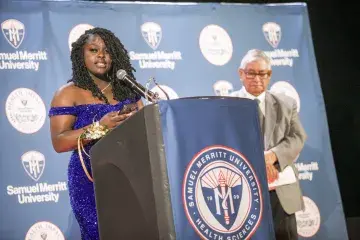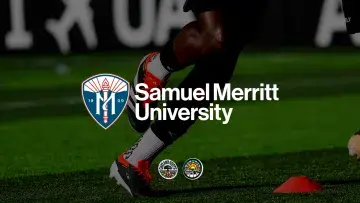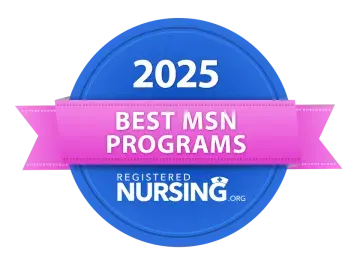Podiatry Students Participate in Nation’s First Simulated Internal Medicine Rotation
Podiatry student Cassy Okoye entered the hospital room of a 45-year-old woman experiencing chest pain and shortness of breath. The patient told Okoye that the pain began the night before while she was playing soccer and returned the next morning when she took out the garbage.
While taking her medical history, Okoye learned that the patient was a smoker whose father died of a heart attack at 47. Okoye soon realized that her patient was also having a heart attack.
The scenario took place in Samuel Merritt University’s Health Science Simulation Center at the start of a month-long clinical rotation for three third-year students from the California School of Podiatric Medicine. It is the only known internal medicine rotation in podiatry in the country delivered entirely in a  simulated environment.
simulated environment.
Though lifelike, Okoye’s patient was actually a high-fidelity manikin in a red wig powered by computer software to replicate human physiological responses. In an adjacent control room behind a one-way mirror, Dr. Bill Stiers impersonated the patient’s voice through a microphone. With the click of a few keys on his computer, Stiers caused the patient to develop an irregular heartbeat, or arrhythmia.
Okoye saw the bedside monitor light up when the patient’s heart suddenly stopped beating so she called in the rapid response team. Fellow student Katie Pettibone set up electrodes on the patient’s chest to shock her heart and also performed chest compressions. After a few moments, Okoye checked her pulse but there was none.
The simulation course, modeled after a program in Australia, provides students with the opportunity to learn from their mistakes without doing any harm to patients.
“In simulation, knowledge and performance gaps are celebrated so mistakes are not crimes to be punished but opportunities for learning,” Stiers told the students. “You will fail your way to success.”
The rotation has been so successful that since it began in 2014, SMU podiatry students have scored 20 percent above the national average on their national board exams in internal medicine.
The Simulation Center, considered one of the most advanced in the West, provides students with clinical skills training through interaction with the computerized models that realistically display breathing, eye movements and pulse sounds. Their heart, blood vessels, lungs and gastrointestinal tract can respond to any number of human interventions. An intravenous needle can penetrate their skin and simulated blood can be pumped into their veins.
Each week, the students also interact with a professional actor who plays a scripted role of a "standardized patient" complete with a chief health complaint and medical history. Students examine the patient using a stethoscope that transmits digitally recorded sounds such as wheezing or a heart murmur to give them clues to reach a diagnosis. Following the mock exam, the patient shares their experience of being under the student’s care, focusing on such attributes as empathy, compassion and attentiveness.
Stiers, who spent 30 years working as an emergency medicine physician, said students appreciate simulation because it is more hands-on than some hospital rotations where they just peer over the shoulder of a resident physician.
Like all of the University’s Doctor of Podiatric Medicine (DPM) students, Okoye, Pettibone and Natalie Coriaty began conducting podiatric exams on patients in their second year. But because their previous clinical rotations in diabetes and surgery were spent primarily as observers, they said they were excited by the possibilities of simulation-based learning.
“It’s nice to get immediate feedback so you can see your strengths and weaknesses, particularly when someone can see what you’re doing as opposed to telling an attending physician about it later,” said Okoye.
In contrast to the unpredictability of the types of medical conditions found in hospitals, the simulation rotation exposes the students to a wide range of pathologic states through a library of cases in cardiology, pulmonology, neurology and perioperative management. Each case scenario includes a patient’s medical conditions, social circumstances, psychological issues, addictions and family dynamics.
“Your patients will tell you what’s wrong with them, you just have to ask the right questions,” Stiers tells the students. “It’s like a treasure hunt and all of the pieces fit together like a puzzle.”
Before the students’ first interaction, Stiers instructed them to suspend their disbelief and care for the manikin with professionalism, compassion and empathy as if it were a real patient. However, he acknowledged that the patient simulator has limitations.
“He’s not going to get up and dance around the room,” he said. “I ask you to engage in a fiction contract that you’ll forgive those discrepancies between reality and the simulated environment.”
During each videotaped 20 to 30-minute engagement with a patient, one student performs the exam, one is the scribe and the third observes. Stiers and the students reconvene in a conference room to discuss the case and work together to develop up to 10 differential diagnoses, which they must argue for and against.
“They collect their own data, filter their findings through their knowledge base, and take action based on it,” said Stiers. “If they’re correct, the patient gets better. If they’re not, the patient gets worse. The great safety feature of simulation is that it’s safe for them to fail.”
The students said they welcomed the educational freedom of simulation.
“A big benefit is working in an environment where we’re not afraid to make mistakes,” said Pettibone. “Bill is good at giving feedback that doesn’t feel like we’re being disparaged.”


